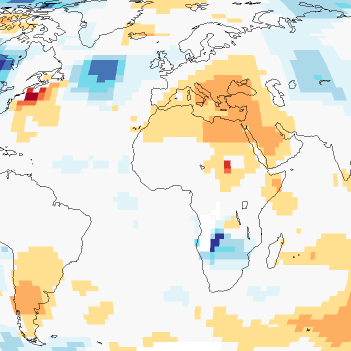As we reach the end of a likely record breaking year for global temperatures, what might we expect for 2015? Continue reading Climate forecasts for 2015
Category Archives: observations
Is there a pause in the temperature of the lower troposphere?
In my recent post whether there is a ‘hiatus’ in global warming I left out the satellite observations of the lower troposphere. The reason for that was that the analysis of these is different from that of the near-surface series, and I considered the latter were more relevant. First, most of us live at ground level most of the time, and secondly this has traditionally been the main measure by which to gauge global warming. My conclusions were that there has been a positive trend since 1998, but no trend over the last 10 years. However, the natural variability of 10-year trends is so large that this is compatible with the positive long-term trend. The indicator of global warming with the best signal-to-noise ratio, ocean heat content, shows no sign of stopping over the last 10 years.
Guest post by Geert Jan van Oldenborgh, KNMI Continue reading Is there a pause in the temperature of the lower troposphere?
Central England Temperature in 2014
2014 was a warm year for much of Europe and the globe, and may end up being the warmest year on record globally. But, no-one experiences a global mean temperature directly, so how about more locally? Can the signal of a warming climate be seen?

Hiatuses in the rise of temperature
“In the last few years the warming trend of the earth has stopped” is a common type of remark these days. Is that indeed the case, and can we conclude that the projections for the rest of the century are being overestimated? And if so, how come that large parts of Europe are expected to have the warmest year recorded in 2014? There is a chance that the global mean temperature will also be the highest in the series.
Guest post by Geert Jan van Oldenborgh, KNMI Continue reading Hiatuses in the rise of temperature
Visualising UK summer temperatures – what are the odds?
How will UK summer temperatures change in future? And, how might we best communicate the possibilities? This is a short post describing one effort in visualising the possible outcomes. Continue reading Visualising UK summer temperatures – what are the odds?
Top-of-atmosphere contribution to unforced variability in global temperature
As the attention received by the ‘global warming hiatus’ demonstrates, global mean surface temperature (T) variability on decadal timescales is of great interest to both the general public and to scientists. Here, I will discuss a recently published paper (Brown et al., 2014) that attempts to contribute to this scientific discussion by investigating the impact of unforced (internal) changes in the earth’s top-of-atmosphere (TOA) energy budget on decadal T variability.
Guest post by Patrick Brown (Duke University) Continue reading Top-of-atmosphere contribution to unforced variability in global temperature
The signal, the noise & the time of emergence
Temperatures have increased over most parts of the planet, but this signal is somewhat obscured by the random noisy fluctuations of natural climate variability. The year in which we can we detect the ‘signal’ of temperature change in the presence of the ‘noise’ is often called the ‘time of emergence’. This is the first of a series of posts on this topic this week. Continue reading The signal, the noise & the time of emergence
Improving the weather from 96 years ago
Ideally, we would have observations of past weather everywhere for several centuries to reconstruct the state of the atmosphere and learn about its variability. But, we don’t.
Instead, all the observations ever taken would, ideally, be available digitally for everyone to use. But, they aren’t. Many past observations are buried in hand-written journals and logbooks, gathering dust in libraries and archives all over the world. Rescuing this data would be of great benefit to reconstructing past weather, as this example will show. Continue reading Improving the weather from 96 years ago